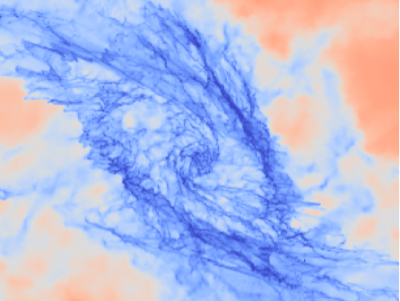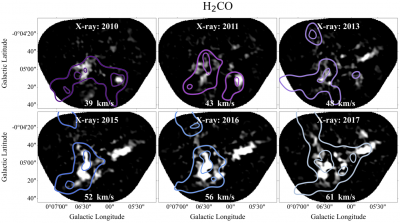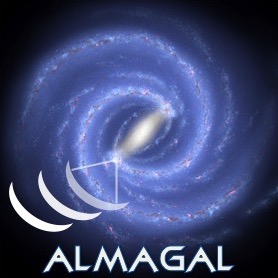Research in the Milky Way Laboratory

Decades of research have uncovered the basic formation mechanisms of stars in our own solar neighborhood, however, most stars in the Universe were formed in ‘extreme’ environments with conditions vastly different than the relative calm of our local universe. Our work capitalizes on the one cosmologically representative region that is close enough to study individual protostellar cores, the Central Molecular Zone (CMZ, the inner 500 pc of the Milky Way). The Milky Way Laboratory research group focuses on using our Galaxy as a laboratory for understanding star formation throughout the Universe with both observations and simulations.
The Milky Way Lab is a fun group, meet the people who make the research happen on our MW Lab Team page. The UConn Astrophysics group is inclusive, thoughtful, collaborative, and awesome at astrophysics.
The MW Lab team is always working on exciting projects. Below are a few current project highlights, but also check out the news page for updates.

Gas Flows and Star Formation in the Central Molecular Zone

PI Battersby believes that we are in a golden age for understanding our Galaxy’s Central Molecular Zone (CMZ). We have unprecedented high-resolution large surveys (CMZoom ; Battersby et al. 2020 and ACES of the region and are developing numerical simulations (Lipman et al. in prep; Sormani et al. 2020; Tress et al. 2020; Hatchfield et al. 2021) that are beginning to closely resemble our Galaxy’s Center. By combining both observations and simulations, we aim to unravel mysteries that have long plagued astronomers, such as: 1) how and when does the supermassive black hole at the Galactic Center feed? 2) what controls gas flows into the central region of the Galaxy? 3) how does star formation depend on Galactic environment?

3-D CMZ
One key piece of the Galactic Center puzzle is understanding the 3D structure of the CMZ. The CMZ is the only galaxy center we can presently study in exquisite detail, yet the diverse physics in this region connects communities across the electromagnetic spectrum. With its extreme properties, the CMZ bridges the gap from our local, quiescent environment to more distant galaxies. The 3-D CMZ project produces, for the first time, a comprehensive, self-consistent 3-D picture of the CMZ. This map is relevant for communities across astrophysics, impacting constraints on dark-matter annihilation in the Galactic Center and allowing us to test the universality of a star formation-dense gas relationship. We’ve published a series of papers on this project, read more on our News page and the associated links.
3D MC: Mapping Circumnuclear Molecular Clouds from X-ray to Radio

We combine archival Chandra X-ray data, Herschel data, and ground-based radio data to perform the first 3-D mapping of molecular clouds within the Central Molecular Zone (CMZ) of our Galaxy. See our news article with associated links to our published papers, press conference, and more. Chandra has detected X-ray reflections in the CMZ caused by previous flaring events of SgrA* propagating outwards and interacting with the surrounding molecular gas. As the X-rays propagate radially outwards, they reflect and illuminate different parts of the cloud, mapping it over time, like an X-ray scan. Different epoch Chandra observations slice through the 3-D structure of the molecular clouds. We combine these multi-epoch Chandra X-ray data with archival Herschel and ground-based radio spectral line data to map the molecular clouds in 3D.
One of the coolest parts of this project is that we can combine with our 3D CMZ results to constrain past flaring events on SgrA*! Super cool. More coming soon.
How does Star Formation Vary Across the Disk of the Galaxy?

We utilize an unprecedented new large program from ALMA, ALMAGAL, to uncover how star formation varies across our Galaxy. ALMAGAL is a Cycle 7 large program on ALMA (2019.1.00195.L, PIs: Cara Battersby, Paul Ho, Sergio Molinari, Peter Schilke) dedicated to studying the evolution of high-mass protocluster formation in the Galaxy. ALMAGAL will observe at 1mm continuum and lines more than 1000 dense clumps with M>500 M_sun and d < 7.5 kpc with similar linear resolution. The sample covers all evolutionary stages from IRDC to HII regions from the tip of the Bar to the outskirts of the Galaxy. The setup with 0.1 mJy sensitivity will enable a complete study of the clump-to-core fragmentation process down to at least 1000 AU and 0.3 M_sun Galaxy-wide, mapping the temperature and the local/global infall velocity patterns of the cores-hosting clumps. ALMAGAL publicly accessible data cubes and catalogs will be an invaluable legacy of ALMA, that will allow numerous community followup studies.
The Future of Astrophysics

Prof. Battersby has long been an advocate for an ambitious future for astrophysics, first as a science and technology definition team member for the Origins Space Telescope and now as a Co-I of the new PRIMA (PRobe far-Infrared Mission for Astrophysics) probe mission concept in Phase A for submission to NASA. PRIMA will offer the science community the capability to explore a wide range of problems in astronomy, from the growth of stars and black holes over cosmic time, the rise of metals, the role of cosmic magnetic fields, star and planet formation, and the origins of Earth’s water.